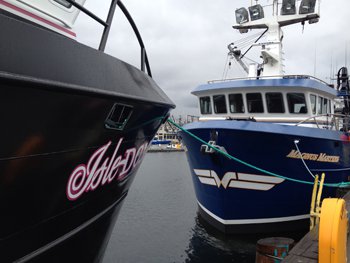If you’ve been wanting a 58-foot fishing boat or maybe a 75-footer but couldn’t afford the expenses that came along with building it to the classification requirements, well, grab your checkbook and sign up for that boat. Because the Coast Guard requirement that boats between 50 and 79 feet have to be classed has been rescinded. No longer must they be designed and built with the approval of a classification society, such as ABS or DNV.
The 58-foot Isle Dominator and Magnus Martens tied up at Seattle's Fishermen's Terminal shortly after being launched in 2013 from Fred Wahl Marine Construction in Reedsport, Ore. Jessica Hathaway photo.I’m not sure how much good was accomplished by including in the Coast Guard authorization Act of 2010 the requirement that a commercial fishing boat 50 feet and over be designed and built to classification requirements.
At least one boatyard went out of business because it had invested a lot of money in a new mold to build a 58 footer. Then the class requirement came into play, which would have jacked up the price of a boat by 25 to 40 percent. Suddenly no one wanted to invest money in this boatyard’s new hulls or hulls from others for that matter that didn’t have a keel laid prior to July 1, 2013, thus circumventing the rule.
Some fishermen, unable to afford a new boat built to the class requirements, threw a lot of money at rebuilding an older hull that probably should have been retired. Others built a boat at 49 feet 11 inches long — thus avoiding classification expenses — when they wanted a 58 foot or 65 footer. That 49 footer is probably not as safe as the larger boats.
But now as long as the boat is between 50 and 79 feet you don’t have to worry about the expense and hassle of working with a classification society. Though if the boat is over 79 feet it has to be classed and load lined.
However, building between 50 and 79 feet, while now much more affordable, isn’t quite as easy as it was before the Coast Guard Authorization Act.
The boat has to be designed by a naval architect or marine engineer licensed by the State and be designed to standards equivalent to those prescribed by a classification society. Many naval architects already design boats to those standards, so this shouldn’t be a problem. The key here is that the plans do not have to be approved by a classification society.
The boatbuilder/designer who bears neither the naval architect or marine engineer title will have to add another step to the process by working with a licensed naval architect to have them approve his plans.
Construction of a new boat now has to be overseen by a marine surveyor to ensure that the design is being followed. The exact involvement of the surveyor in the building process is still being worked out, as are a number of other requirements.







